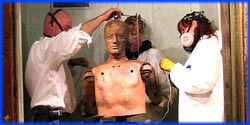


Premier Date: December 13, 2006
busted
In both the small scale and full scale tests, the MythBusters observed that the difference in pressure between the falling person and the shock wave from the blast are too vastly different to be equalized. Also, the glass and metal fragmentation from the explosion would most likely kill the falling person if the fall itself does not.
(This myth originates from a World War II story in which an Allied airman fell out of the underside ball turret of his B-17 at 22,000 feet and survived.)
busted
Through numerous tests, the MythBusters calculated that the power surge from turning on a light would only consume as much power as leaving it on for a fraction of a second (except for fluorescent tube lights; the startup consumed about 23 seconds worth of power). Furthermore, the wear and tear of turning the light on and off repeatedly did not reduce the bulb’s total life expectancy enough to offset the increased electricity usage. Therefore, it is far more economical to turn a light off rather than leaving it on.